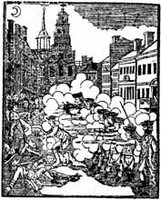The Autopsy of Crispus Attucks
 CSI: Colonial Boston continues with the sworn report of Dr. Benjamin Church, Jr., about his examination of the body of Crispus Attucks after the Boston Massacre:
CSI: Colonial Boston continues with the sworn report of Dr. Benjamin Church, Jr., about his examination of the body of Crispus Attucks after the Boston Massacre:
I, Benjamin Church, Jun., of lawful age, testify and say, that being requested by Mr. Robert Pierpont, the Coroner, to assist in examining the body of Crispus Attucks, who was supposed to be murdered by the soldiers on Monday evening the 5th instant, I found two wounds in the region of the thorax, the one on the right side, which entered through the second true rib within an inch and a half of the sternum, dividing the rib and separating the cartilaginous extremity from the sternum, the ball passed obliquely downward through the diaphragm and entering through the large lobe of the liver and the gall-bladder, still keeping its oblique direction, divided the aorta descendens just above its division into the iliacs, from thence it made its exit on the left side of the spine. This wound I apprehended was the immediate cause of his death.This deposition was dated 22 Mar 1770, and published in Boston’s official report on the shootings, titled A Short Narrative of the Horrid Massacre. More than two weeks had passed since the event, and the British soldiers who had been on King Street on the 5th of March were already jailed and indicted.
The other ball entered the fourth of the false ribs, about five inches from the linea alba, and descending obliquely passed through the second false rib, at the distance of about eight inches from the linea alba; from the oblique direction of the wounds, I apprehend the gun must have been discharged from some elevation, and further the deponent saith not.
BENJ. CHURCH, Jun.
Church’s autopsy report was significant because it pointed the finger at other suspects as well. The fact that the two musket balls “passed obliquely downward” through Attucks’s body implied that they had entered his chest on a slant. But how could that be if they had come from guns held by men of the same size (or possibly a bit smaller), standing no more than a few feet in front of Attucks on King Street?
To Boston’s Whigs, this autopsy helped to confirm an accusation that people employed by the Customs service had fired down on the crowd from the upper storey of their office behind the soldiers. “From some elevation,” as Church said. Four days after the doctor wrote out his deposition, a Suffolk County jury indicted four Customs employees for murder.
Eventually those suspects were all acquitted, and their main accuser convicted of perjury. So how did the musket balls travel “obliquely downward” through Attucks’s torso? One explanation I’ve seen connects this detail with some testimony that Attucks was leaning on a piece of firewood when he was shot. If he was somewhat crouched, and perhaps ducking after Pvt. Edward Montgomery’s opening shot, then one of the next shots could have sent two balls through his chest on a slant—but it was his chest that was oblique, not the trajectory of the balls.

No comments:
Post a Comment